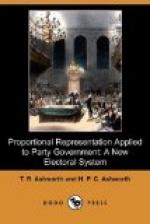It remains to show that to give effect to the expression of these two principles in a more perfect manner than ever yet attained is a problem of electoral machinery. This task we shall now undertake.
FOOTNOTES:
[2] “Representative Government in England,” p. 123.
[3] Age, 28th June, 1900.
CHAPTER IV.
THE REFORM: TRUE PROPORTIONAL REPRESENTATION.
How to give effect to the principles of organization and leadership in an electoral reform—that is the problem which we shall now attempt to solve. We have already laid down the theoretical requirements, which are (1) proportional representation to the two parties—the majority and the minority, and (2) the election by each party separately of its most popular leaders; and we shall now have to consider also how these requirements are modified by practical considerations.
+Proportional Representation to the Two Parties, the Majority and the Minority.+—It will be as well to illustrate the method proposed by reference to the conditions imposed by an actual election, such as that for the Federal Senate. The Commonwealth Bill provides that each State shall be polled as a single electorate, returning six senators. Suppose that 120,000 electors vote on party lines in any State. It is clear that a party which has the support of 20,000 electors is entitled to one senator; also, that a party which has the support of 40,000 electors is entitled to two senators; of 60,000 electors to three senators, and so on. Now, suppose that one party has the support of 50,000 electors, and the other of 70,000 electors, then the minority is entitled to two and a half senators, and the majority to three and a half senators. But senators are living units, and cannot be divided into fractions. The question therefore arises, Which is entitled to the odd senator, the majority or the minority? And the answer is that they are both equally entitled to him; for it is as much a tie as if each party has the support of 10,000 electors in a single-seat electorate. But if the minority had the support of 49,999 electors, or one elector less, it would be entitled to only two senators, and if it had the support of 50,001 electors, or one elector more, it would be entitled to three senators.
From the above simple facts can be deduced general rules applicable to any particular case. It is evident that the result is not affected by the number of votes allowed to each elector, providing only that each elector has the same number of votes. It is also quite irrespective of the number of candidates nominated in the interests of each party. But it would never do to allow party organizations to control nominations. How are we to combine individual candidature with party nomination? The only way to do this is to require that each candidate shall declare, either when nominating or a few days before the election, on which side of the House he intends to sit, and be classified accordingly as Ministerialist or Oppositionist. To decide the relative strengths of the two parties, it is then only necessary to take the aggregate votes polled by all the candidates nominated for each party as a measure of the amount of support which it receives.




